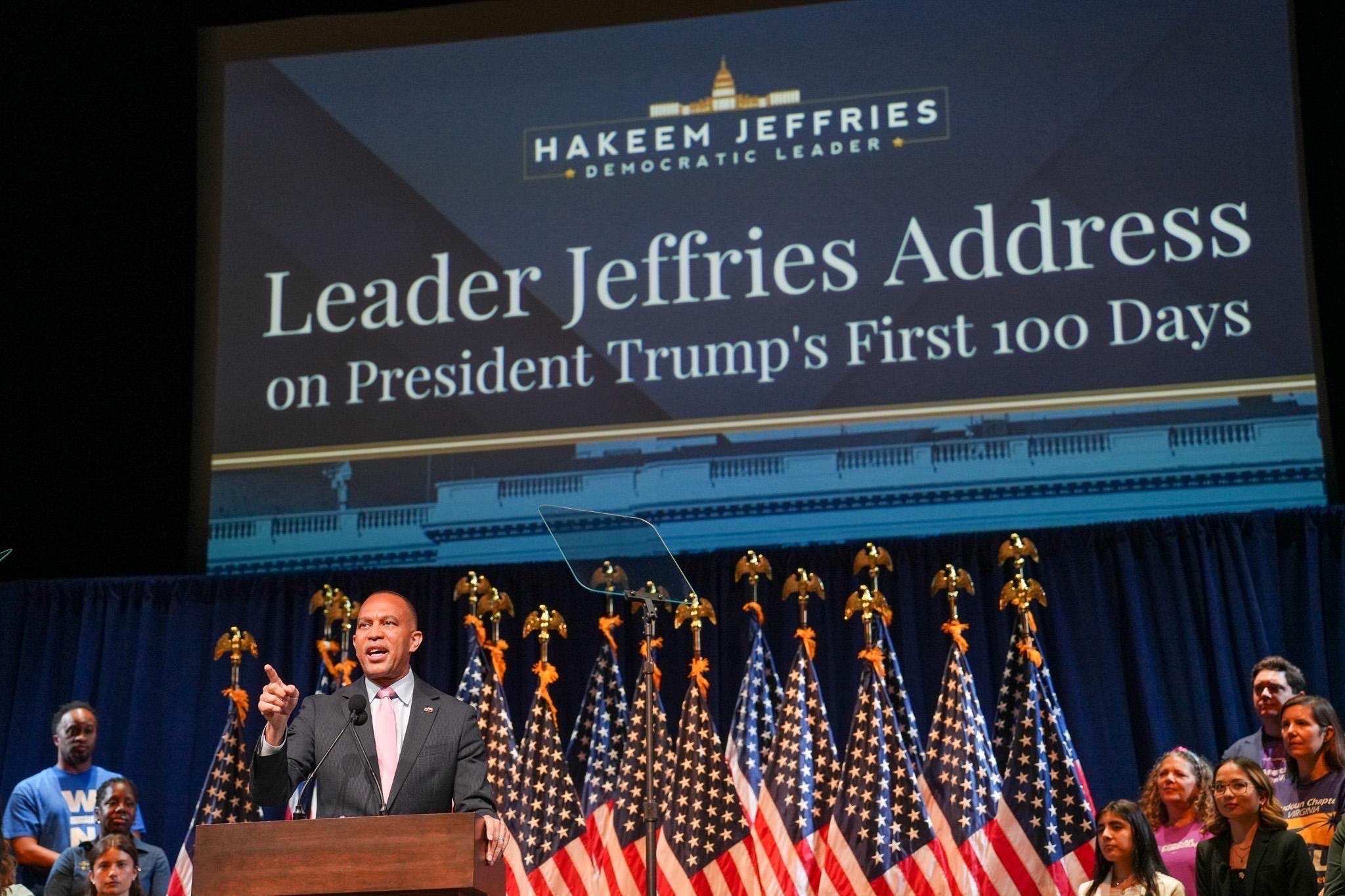Jeffries sets direction for next phase of Trump resistance
In a high-profile speech just a mile from the Capitol, the top House Democrat previewed a forward-looking agenda while hammering Trump’s first 100 days.

House Minority Leader Hakeem Jeffries (D-N.Y.) didn’t hold back. In a major speech delivered just a mile from the U.S. Capitol on Wednesday morning, he slammed President Donald Trump, Elon Musk, and House Republicans for what he called a disastrous first 100 days of Trump’s second term.
But Jeffries didn’t dwell solely on the past—he looked ahead, announcing that Democrats would spend the next 100 days laying out a blueprint for a better America, a vision that puts the people over the powerful.
If Democrats retake the House in 2026, Jeffries said they’ll prioritize building an affordable economy, confronting the climate crisis, protecting Social Security, Medicare, and Medicaid from GOP-led budget cuts, and holding the Trump administration accountable for what he described as systemic corruption and abuse of power.
Allow me to explain: The 258-seat Atlas Performing Arts Center was nearly full by the time the program began.
Attendees included advocates from groups like Planned Parenthood, the American Federation of Teachers, and the Center for Popular Democracy, many of whom led call-and-response chants from the risers: “No justice, no peace,” “Show me what democracy looks like,” and “Healthcare now.”
A video montage featuring Jeffries and House Democrats criticizing Musk, Project 2025, and Republican efforts to cut federal health and social programs played shortly before he took the stage.
Music from artists including Beyoncé, the Notorious B.I.G., and Mary J. Blige played over the speakers.
Jeffries delivered the speech from a stage flanked by teleprompters—an uncommon setup for a leader known for speaking without a script.
According to a source familiar with the planning, the speech had been in the works for about a month, with the pace picking up in recent days. The venue was not finalized until five days before the event.
Advocates stood behind Jeffries on risers throughout the address, a visual choice that reinforced the theme of people over power.
The structure and delivery were so sharp that several observers—including one source familiar with Jeffries’ style—wondered whether he had written it himself or worked with a trusted campaign hand.
In his own words: Jeffries anchored the speech with several anecdotes that humanized him and spotlighted vulnerable Americans who would be impacted by Republican-proposed cuts to the social safety net.
He recalled a family road trip gone awry, when his then-six-year-old son, expecting a luxe vacation, took one look at their modest motel and declared, “This is a debacle”—a moment Jeffries used to foreshadow his verdict on Trump’s first 100 days.
“This is the moment we are in right now in the United States of America with Donald Trump and Republicans in charge,” Jeffries said. “The first 100 days of the Trump administration have been a debacle.”
In the know: The rest of the speech followed a steady rhythm—personal story, policy threat, political contrast.
Jeffries recounted his first job delivering packages in midtown Manhattan and the surprise of seeing FICA deductions from his paycheck as a teenager.
It became a springboard to defend Social Security and Medicare as earned benefits and to pledge that Democrats would prevent Republicans from “putting their hands on” either program.
He then shared the story of Mary Beth, a grandmother in North Carolina raising four grandchildren on a fixed income.
Medicaid, he said, is the only reason they can access care—especially the youngest, who has ADHD and autism.
Jeffries warned that GOP efforts to slash Medicaid by $880 billion—the largest healthcare cut in U.S. history—would have devastating consequences, calling it a handout to billionaires like Musk at the expense of working families.
From there, he called out Republicans who “vote like extremists” in Washington but campaign as moderates at home. And he closed with a call to faith and resilience, urging Americans to “never give up, never give in” and to continue marching toward “a more perfect union.”
Afterward, he shook hands and took photos with the advocates who stood behind him onstage.
What they’re saying: House Democrats praised Jeffries’ message, framing it as both a sharp indictment of the Trump administration’s first 100 days and a forward-looking blueprint for what Democratic leadership would mean in 2026.
Rep. Luz Rivas (D-Calif.), attending at the invitation of Jeffries’ staff, called the administration “a disaster” and said voters were feeling it in their pocketbooks.
“It was great to see him communicate the caucus’s plan,” she said. “A lot of us are working hard on what Americans will see if Democrats—not if, but when—Democrats are in power.”
Rep. Joyce Beatty (D-Ohio) described the speech as “energizing,” “provocative,” and “profound.”
She said it answered a common voter question: What are Democrats doing? “You heard a plan. You heard action,” she said. “This is what power and energy looks like.”
Rep. Steven Horsford (D-Nev.) said Jeffries didn’t just call out “the chaos, the cruelty, and the corruption of Donald Trump”—he laid out a vision rooted in lowering costs, expanding access to health care and housing and defending public education.
“Most importantly, he made it clear that House Democrats are fighting for the American people, not for billionaires like Donald Trump and Elon Musk,” Horsford added.
How we got here: Jeffries began his tenure as House Democratic leader with unusual leverage for someone in the minority.
Although Republicans won the House in 2022, then-Speaker Kevin McCarthy (R-Calif.) emerged from a bruising 15-round speakership fight significantly weakened.
His inability to govern gave Jeffries outsize influence over major bipartisan deals, including government funding.
When McCarthy was ultimately ousted—with eight Republicans joining all Democrats to remove him—his successor, Mike Johnson, inherited both the gavel and the math.
Narrow margins forced the Louisiana Republican to negotiate with Jeffries on key priorities such as Ukraine aid and the annual defense policy bill, allowing Democrats to protect much of what they had enacted during the 117th Congress.
Everything changed after the 2024 election.
Trump reclaimed the White House. Democrats lost the Senate. And although House Democrats gained seats, they fell just short of a majority—losing three gerrymandered North Carolina districts that might have made Jeffries the first Black speaker in U.S. history.
The party was thrust into a period of painful soul-searching—one that, some would argue, still isn’t over.
Voters rejected the status quo, and some activists and strategists began to question whether Jeffries, once the symbol of a generational shift, had become a liability with Trump back in power.
Tensions boiled over in March, when House Democratic leadership privately urged rank-and-file members not to protest during Trump’s joint address to Congress.
Several safe-seat Democrats staged a walkout anyway, drawing praise from the base and criticism from senior members.
Jeffries declined to publicly back either side, frustrating progressives who felt unsupported and institutionalists who wanted consequences.
Weeks later, the caucus began to unify again. Jeffries led House Democrats in opposing a Republican funding bill that boosted defense spending while slashing domestic programs.
Schumer allowed the bill to pass, citing fears of a shutdown that could embolden Trump allies like Musk.
But Jeffries’ resistance won him goodwill with both members and activists.
Since then, he’s raised his public profile with a flurry of press conferences, interviews, and viral moments—including a 12-hour sit-in outside the Capitol on Sunday with Sen. Cory Booker (D-N.J.).
Jeffries’ speech on Wednesday marked a new phase in his leadership strategy, aimed at sharpening the party’s message and reclaiming political momentum heading into 2026.
Not so fast: Jeffries’ address may have been his most commanding public appearance since his 2023 “ABCs of democracy” speech—but rhetoric alone can’t reshape power dynamics.
No matter how sharply Democrats draw the contrast or how forcefully Jeffries outlines a vision for 2026, they remain in the minority.
As long as congressional Republicans stay united behind Trump’s agenda, House Democrats have limited power to stop it.
That reality tempers even the most stirring political moment.
The big picture: Still, Jeffries’ speech wasn’t just a rebuttal to Trump’s first 100 days—it provides another test of whether Democrats can sharpen their message, unify around a forward-looking agenda, and offer voters a credible alternative before the 2026 midterms.
With limited power in the minority, this kind of public vision-setting may be one of the few tools they have left.

